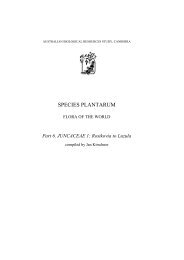Part 7. JUNCACEAE 2: Juncus - Species Plantarum Programme
Part 7. JUNCACEAE 2: Juncus - Species Plantarum Programme
Part 7. JUNCACEAE 2: Juncus - Species Plantarum Programme
Create successful ePaper yourself
Turn your PDF publications into a flip-book with our unique Google optimized e-Paper software.
18<br />
SPECIES PLANTARUM — FLORA OF THE WORLD (2002)<br />
Perennials, (50–) 75–150 cm tall; rhizome creeping, branched, to 10 mm in diam., with<br />
internode length variable. Culms rigid, usually 2–5 mm thick. Leaves 25–110 cm long, 1.5–3 mm<br />
thick. Lower two bracts leaf-like, 5–25 cm long, including a sheath 2–5 cm long, shorter than<br />
to much exceeding the inflorescence; middle bracts small; bracts subtending heads much<br />
shorter than flowers, ovate, amplexicaul, cuspidate. Inflorescence 5–40 × 2–5 cm, lax,<br />
usually elongated, with (20–) 50–150 (–300) heads. Heads (1–) 2–4 (–6)-flowered. Tepals<br />
3.5–5 mm long, equal or outer ones ±longer; margins broad, scarious; outer tepals narrowly<br />
ovate, cymbiform, acute to obtuse, sometimes with small mucro; inner tepals oblong, obtuse, with<br />
margins ±expanded apically. Stamens 6, 2/3– 3/4 as long as tepals; anthers (1.0–) 1.5–2.0 (–2.5) mm<br />
long, 3–6 times as long as filaments; style 0.7–1.2 mm long; stigmas 1–1.5 mm long.<br />
Capsule 3.5–5 mm long, conspicuously exceeding or rarely equalling tepals, narrowly<br />
trigono-ovoid, trilocular, usually straw-brown; apex trigonous, tapering, sometimes abruptly<br />
contracted; mucro to 0.5 mm; seeds usually 70–90. Seeds 0.6–0.7 mm long, or 0.9–1.8 mm<br />
long including appendages, 0.2–0.3 mm broad, narrowly obliquely ovoid, 20–25-striate;<br />
appendages equal or subequal. 2n = 46, 48, fide S.Snogerup, Willdenowia 23: 57 (1993).<br />
Fig. 44.<br />
Common in N Africa, and from scattered localities in W and E Africa. Widely distributed in<br />
S Africa. From Cyprus, Syria, Israel, Red Sea and the Arabian Peninsula, to S Afghanistan<br />
and S Pakistan, and Turkmenistan in the north. Not found in Europe recently. 12: SAR.<br />
13: ITA, SIC. 20: ALG, EGY, LBY, MOR, TUN. 22: MLI, NGR, SEN. 23: ZAI. 24: CHA,<br />
SUD, SOC, SOM. 26: ANG, MLW, MOZ, ZAM, ZIM. 27: BOT, CPP, CPV, LES, NAM,<br />
NAT, OFS, SWZ, TVL. 32: KGZ, TKM, TZK, UZB. 34: AFG, CYP, IRN, IRQ, LBS, PAL,<br />
SIN, TUR. 35: GST, KUW, OMA, SAU, YEM. 40: PAK. Usually sandy saline localities<br />
(both coastal and inland), in desert and steppe regions often near wells, in seasonally wet<br />
depressions. Map 181.<br />
13. ITALY: Sicilia, Noto, Avola, G.Bianca 283 (FI). 20. EGYPT: Wadi Kurkur, 16 Dec 1964, L.Boulos<br />
(CAI, LD). MOROCCO: Jebel Kebir, Dahlgren & P.Lassen 140-22 (LD). 24. CHAD: Oasis Tekro,<br />
J.Hutchinson 2 (BM). 26. ZAMBIA: Mazabuka, Kafue R., van Rensburg 2501 (K). 2<strong>7.</strong> SOUTHERN<br />
AFRICA: Cape Province, Taung, MacDonald 76/2 (NBG); Cape Province, Richmond, Leopard’s Vlei,<br />
H.Bolus 13838 (BOL). 32. TADZHIKISTAN: Amu-Darya, between Kuljab and Gullag, 12–24 Oct 1881,<br />
E.A.Regel (LE). 34. ISRAEL: Dead Sea, near Sedom, 18 Dec 1938, M.Zohary & Yehoudai [Fl. Terr. Israel.<br />
Exs.] 721 (BM, E, FI, G, K, LD, NSW). 40. PAKISTAN: ENE Karachi, Khadeji, K.H.Rechinger 28569 (W).<br />
<strong>7.</strong> <strong>Juncus</strong> kraussii Hochst., in C.Krauss, Flora 28: 342 (1845)<br />
T: South Africa, George Distr., Notsinakama R., Jan 1839, C.Krauss; lecto: G-BOIS, fide S.Snogerup,<br />
Willdenowia 23: 57 (1993); iso: M.<br />
Perennials, c. 40–130 (–200) cm tall; rhizome creeping, short-noded, densely branched.<br />
Leaves terete, 20–100 cm long, 1–5 mm in diam. Lower two bracts leaf-like with wide<br />
sheaths, usually exceeding inflorescence; middle bracts narrowly ovate, amplexicaul,<br />
acuminate, often with a small, distinct lamina; bracts subtending heads ovate, shorter to<br />
±equalling flowers, scarious. Inflorescence usually lax, rarely consisting of a few clusters.<br />
Flowers dark. Tepals ±unequal; outer tepals longer, with base and midrib herbaceous, with<br />
margins scarious, ovate, cymbiform, keeled, with scarious margin slightly broader distally,<br />
very fragile; mucro 0.1–0.3 mm long; inner tepals oblong, subobtuse to obtuse. Anthers<br />
shorter than tepals. Capsule 2–2.5 (–3) mm long, trigono-obovoid to trigono-ellipsoidal,<br />
usually obtuse, dark brown to castaneous at least in apical part. Seeds with very short<br />
unequal appendages.<br />
Disjunct in three areas: Southern Africa, along the S and SE coast to Mozambique; Australia,<br />
Tasmania and New Zealand; and temperate South America. There are three subspecies.<br />
1 Dioecious, with functionally unisexual flowers; inflorescence broad 7a. subsp. kraussii<br />
1: Flowers usually hermaphrodite; inflorescence elongated to broad<br />
2 Capsule exceeding perianth; inflorescence elongated 7b. subsp. australiensis<br />
2: Capsule equalling perianth; inflorescence broad 7c. subsp. austerus












